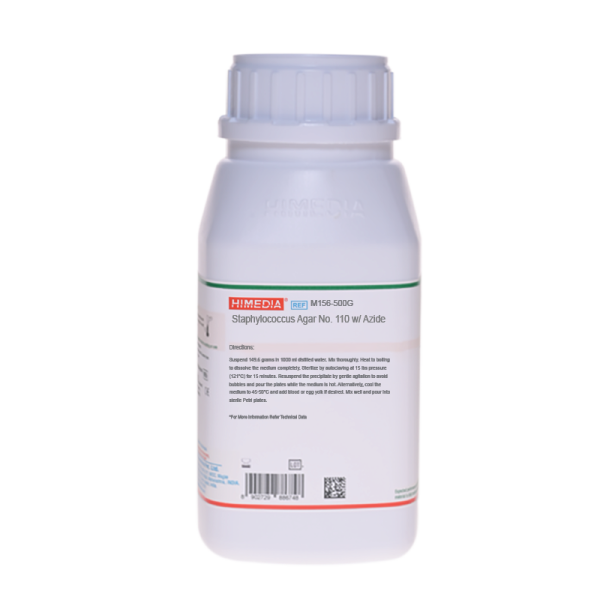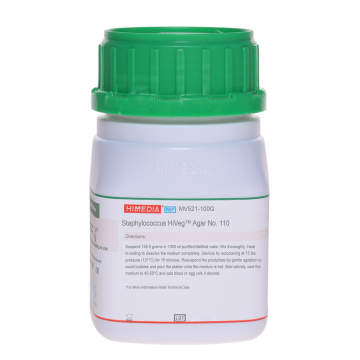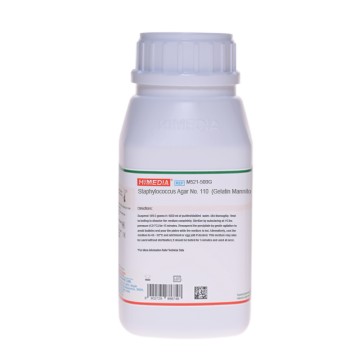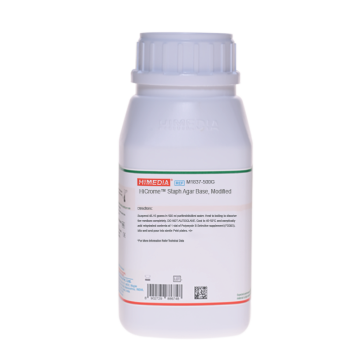 Your enquiry has been submitted
Your enquiry has been submitted
Staphylococcus Agar No. 110 w/ Azide
Intended Use
Recommended for selective isolation and testing of pathogenic Staphylococci.
Composition**
| Ingredients | g / L |
|---|---|
| Tryptone | 10.000 |
| Yeast extract | 2.500 |
| Gelatin | 30.000 |
| Lactose | 2.000 |
| D-Mannitol | 10.000 |
| Sodium chloride | 75.000 |
| Dipotassium hydrogen phosphate | 5.000 |
| Sodium azide | 0.100 |
| Agar | 15.000 |
Final pH ( at 25°C): 7.0±0.2
**Formula adjusted, standardized to suit performance parameters
Directions
Suspend 149.6 grams in 1000 ml of warm purified / distilled water. Mix thoroughly. Heat to boiling to dissolve the medium completely. Sterilize by autoclaving at 15 lbs pressure (121°C) for 15 minutes. Resuspend the precipitate by gentle agitation to avoid bubbles and pour the plates while the medium is hot. Alternatively, cool the medium to 45 - 50°C and add blood or egg yolk if desired.
Principle And Interpretation
Staphylococcus Agar No. 110 is formulated as described by Chapman (1, 2, 3) for selective isolation and enumeration of Staphylococci from clinical as well as nonclinical specimens. Staphylococcus Agar No. 110 with azide is used for determination of coagulase positive Staphylococci in meat pies even in the presence of large number of Bacillus species (4). This medium is recommended by APHA (5). The addition of blood in the medium enables to study haemolytic reaction (6) and with egg yolk enables to study lecithinase production by Staphylococcus aureus (7). This medium is selective due to high salt concentration and differential on the basis of ability of organism to ferment mannitol, produce pigment and gelatin liquefaction.
This medium is very nutritive as it contains tryptone and yeast extract which provide essential growth factors like vitamins, nitrogen, carbon compounds, sulphur and trace nutrients etc. to the organisms. High concentration of sodium chloride inhibits many bacterial species except Staphylococci. Sodium azide inhibits gram-negative organisms. Mannitol fermentation can be visualized as yellow colouration by addition of a few drops of bromo thymol blue to the areas of the plates from where colonies have been removed. Gelatin liquefaction can be seen when the plates are flooded with a saturated aqueous solution of ammonium sulphate. Enterococcus faecalis may grow on this medium as small colonies with little mannitol fermentation (8).
Type of specimen
Clinical samples : Pus, wounds, stool, etc; Food samples
Specimen Collection and Handling
For clinical samples follow appropriate techniques for handling specimens as per established guidelines (9,10).
For food samples, follow appropriate techniques for sample collection and processing as per guidelines (8).
After use, contaminated materials must be sterilized by autoclaving before discarding.
Warning and Precautions
In Vitro diagnostic use. For professional use only. Read the label before opening the container. Wear protective gloves/protective clothing/eye protection/face protection. Follow good microbiological lab practices while handling specimens and culture. Standard precautions as per established guidelines should be followed while handling clinical specimens. Safety guidelines may be referred in individual safety data sheets.
Limitations
- Enterococcus faecalis may grow on this medium as small colonies with little mannitol fermentation (11).
- Further serological and biochemical testing is required on colonies of pure culture for complete identification.
Performance and Evaluation
Performance of the medium is expected when used as per the direction on the label within the expiry period when stored at recommended temperature.
Quality Control
Appearance: Cream to yellow homogeneous free flowing powder
Gelling: Firm, comparable with 1.5% Agar gel and 3.0% gelatin gel
Colour and Clarity of prepared medium: Light amber coloured clear to slightly opalescent gel forms in Petri plates
Reaction: Reaction of 14.96% w/v aqueous solution at 25°C. pH : 7.0±0.2
pH: 6.80-7.20
Cultural Response: Cultural characteristics observed after an incubation at 35-37°C for 48 hours.
| Organism | Inoculum (CFU) | Growth | Recovery | Mannitol fermentation (on addition of BTB) | Pigment Production | Gelatinase production (flooding plate with standard aqueous solution of ammonium sulphate) |
|---|---|---|---|---|---|---|
| Staphylococcus aureus subsp. aureus ATCC 25923 (00034*) | 50-100 | good-luxuriant | >=50% | positive reaction | positive | positive reaction |
| Staphylococcus epidermidis ATCC 12228 (00036*) | 50-100 | good-luxuriant | >=50% | variable reaction | negative | positive reaction |
| Enterococcus faecalis ATCC 29212 (00087*) | 50-100 | none-poor | <=10% | slight reaction | negative | variable reaction |
| Escherichia coli ATCC 25922 (00013*) | >=104 | Inhibited | 0% |
Key : (*) Corresponding WDCM numbers.
Storage and Shelf Life
Store between 10-30°C in a tightly closed container and the prepared medium at 20-30°C. Use before expiry date on the label. On opening, product should be properly stored dry, after tightly capping the bottle in order to prevent lump formation due to the hygroscopic nature of the product. Improper storage of the product may lead to lump formation. Store in dry ventilated area protected from extremes of temperature and sources of ignition Seal the container tightly after use. Product performance is best if used within stated expiry period.
Disposal
User must ensure safe disposal by autoclaving and/or incineration of used or unusable preparations of this product. Follow established laboratory procedures in disposing of infectious materials and material that comes into contact with clinical sample must be decontaminated and disposed of in accordance with current laboratory techniques (9,10).
Reference
- Chapman G.H., 1946, J. Bact., 51:409.
- Chapman G.H., 1948, Food Res., 13:100.
- Chapman G.H., 1952, J. Bact., 63:147.
- Smucker S.A. and Appleman M.D., 1964, Appl. Microbiol., 12(4):355.
- Speck M. (Ed.), 1984, Compendium of Methods for the Microbiological Examination of Foods, 2nd ed., APHA, Washington, D.C
- Shaffer J. C. and McDade J. J., 1962, Arch. Environ. Health, 5:547.
- Carter C.H., 1960, J. Bact., 79:753.
- Salfinger Y., and Tortorello M.L. Fifth (Ed.), 2015, Compendium of Methods for the Microbiological Examination of Foods, 5th Ed., American Public Health Association, Washington, D.C.
- Isenberg, H.D. Clinical Microbiology Procedures Handbook 2nd Edition.
- Jorgensen, J.H., Pfaller, M.A., Carroll, K.C., Funke, G., Landry, M.L., Richter, S.S and Warnock., D.W. (2015) Manual of Clinical Microbiology, 11th Edition. Vol. 1.
- MacFaddin J., 1985, Media for Isolation-Cultivation-Identification-Maintenance of Medical Bacteria, Vol. I, Williams and Wilkins, Baltimore.
| Product Name | Staphylococcus Agar No. 110 w/ Azide |
|---|---|
| SKU | M156 |
| Product Type | Regular |
| Physical Form | Powder |
| Origin | Animal |
| Packaging type | HDPE |
| References | 1. Chapman G.H., 1946, J. Bact., 51:409. 2.Chapman G.H., 1948, Food Res., 13:100. 3.Chapman G.H., 1952, J. Bact., 63:14 4.Carter C.H., 1960, J. Bact., 79:75 3. 5.Isenberg, H.D. Clinical Microbiology Procedures Handbook 2nd Edition. 6.Jorgensen,J.H., Pfaller,M.A., Carroll, K.C., Funke, G., Landry, M.L., Richter, S.S and Warnock.,D.W. (2015) Manual of Clinical Microbiology, 11th Edition. Vol. 1. 10.Smucker S.A. and Appleman M.D., 1964, Appl. Microbiol., 12(4):355 |
| Customized Product Available | No |








